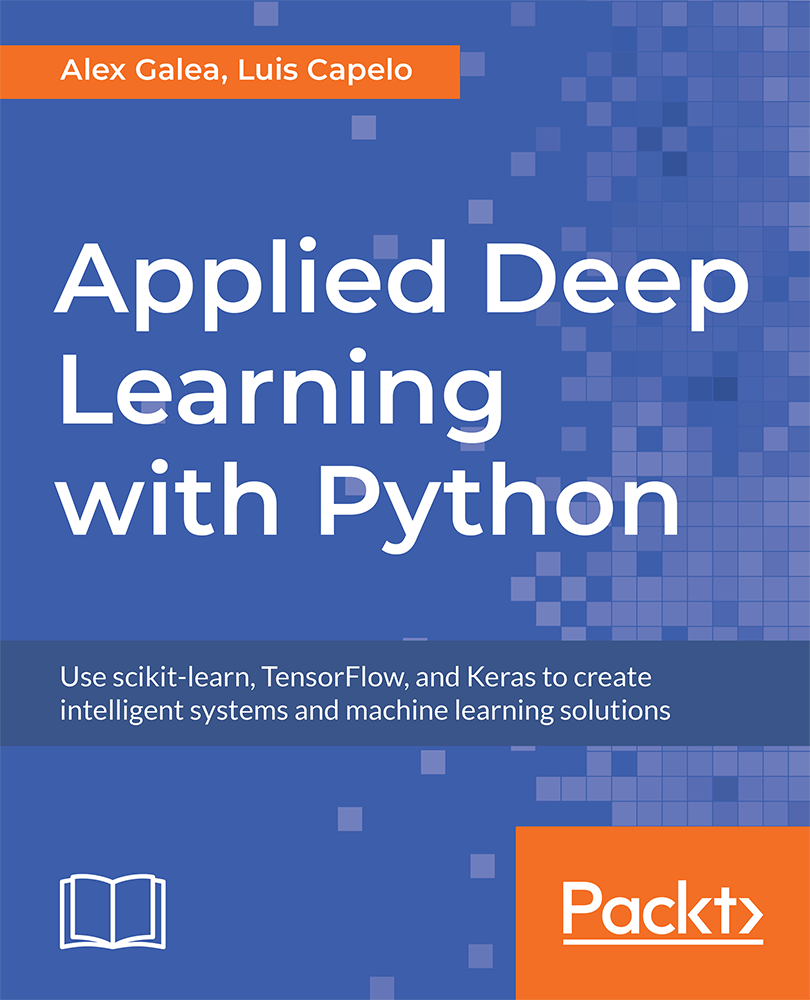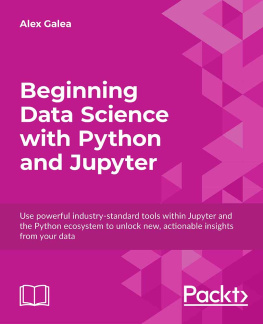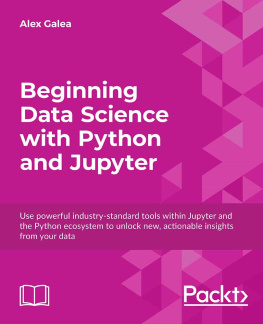
Applied Deep Learning with Python
Use scikit-learn, TensorFlow, and Keras to create intelligent systems and machine learning solutions
Alex Galea
Luis Capelo

BIRMINGHAM - MUMBAI
Applied Deep Learning with Python
Copyright 2018 Packt Publishing
All rights reserved. No part of this book may be reproduced, stored in a retrieval system, or transmitted in any form or by any means, without the prior written permission of the publisher, except in the case of brief quotations embedded in critical articles or reviews.
Every effort has been made in the preparation of this book to ensure the accuracy of the information presented. However, the information contained in this book is sold without warranty, either express or implied. Neither the authors, nor Packt Publishing or its dealers and distributors, will be held liable for any damages caused or alleged to have been caused directly or indirectly by this book.
Packt Publishing has endeavored to provide trademark information about all of the companies and products mentioned in this book by the appropriate use of capitals. However, Packt Publishing cannot guarantee the accuracy of this information.
Acquisitions Editors: Aditya Date, Koushik Sen
Content Development Editors: Tanmayee Patil, Rina Yadav
Production Coordinator: Ratan Pote
First published: August 2018
Production reference: 131082018
Published by Packt Publishing Ltd.
Livery Place
35 Livery Street
Birmingham
B3 2PB, UK.
ISBN 978-1-78980-474-4
www.packtpub.com
mapt.io
Mapt is an online digital library that gives you full access to over 5,000 books and videos, as well as industry leading tools to help you plan your personal development and advance your career. For more information, please visit our website.
Why subscribe?
Spend less time learning and more time coding with practical eBooks and Videos from over 4,000 industry professionals
Improve your learning with Skill Plans built especially for you
Get a free eBook or video every month
Mapt is fully searchable
Copy and paste, print, and bookmark content
Packt.com
Did you know that Packt offers eBook versions of every book published, with PDF and ePub files available? You can upgrade to the eBook version at www.Packt.com and as a print book customer, you are entitled to a discount on the eBook copy. Get in touch with us at service@packt.com for more details.
At www.PacktPub.com , you can also read a collection of free technical articles, sign up for a range of free newsletters, and receive exclusive discounts and offers on Packt books and eBooks.
Contributors
About the authors
Alex Galea has been professionally practicing data analytics since graduating with a Master's degree in Physics from the University of Guelph, Canada. He developed a keen interest in Python while researching quantum gases as part of his graduate studies. Alex is currently doing web data analytics, where Python continues to play a key role in his work. He is a frequent blogger about data-centric projects that involve Python and Jupyter Notebooks.
Luis Capelo is a Harvard-trained analyst and programmer who specializes in the design and development of data science products. He is based in the great New York City, USA.
He is the head of the Data Products team at Forbes, where they both investigate new techniques for optimizing article performance and create clever bots that help them distribute their content. Previously, he led a team of world-class scientists at the Flowminder Foundation, where we developed predictive models for assisting the humanitarian community. Prior to that, he worked for the United Nations as part of the Humanitarian Data Exchange team (founders of the Center for Humanitarian Data).
He is a native of Havana, Cuba, and the founder and owner of a small consultancy fim dedicated to supporting the nascent Cuban private sector.
About the reviewers
Elie Kawerk likes to solve problems using the analytical skills he has accumulated over the years. He uses the data science process, including statistical methods and machine learning, to extract insights from data and get value out of it.
His formal training is in computational physics. He used to simulate atomic and molecular physics phenomena with the help of supercomputers using the good old FORTRAN language; this involved a lot of linear algebra and quantum physics equations.
Manoj Pandey is a Python programmer and the founder and organizer of PyData Delhi. He works on research and development from time to time, and is currently working with RaRe Technologies on their incubator program for a computational linear algebra project. Prior to this, he has worked with Indian startups and small design/development agencies, and teaches Python/JavaScript to many on Codementor.
Packt is searching for authors like you
If you're interested in becoming an author for Packt, please visit authors.packtpub.com and apply today. We have worked with thousands of developers and tech professionals, just like you, to help them share their insight with the global tech community. You can make a general application, apply for a specific hot topic that we are recruiting an author for, or submit your own idea.
Preface
This Learning Path takes a step-by-step approach to teach you how to get started with data science, machine learning, and deep learning. Each module is designed to build on the learning of the previous chapter. The book contains multiple demos that use real-life business scenarios for you to practice and apply your new skills in a highly relevant context.
In the first part of this Learning Path, you will learn entry-level data science. You'll learn about commonly used libraries that are part of the Anaconda distribution, and then explore machine learning models with real datasets to give you the skills and exposure you need for the real world.
In the second part, you'll be introduced to neural networks and deep learning. You will then learn how to train, evaluate, and deploy Tensorflow and Keras models as real-world web applications. By the time you are done reading, you will have the knowledge to build applications in the deep learning environment and create elaborate data visualizations and predictions.
Who this book is for
If youre a Python programmer stepping out into the world of data science, this is the right-way to get started. It is also ideal for experienced developers, analysts, or data scientists, who want to work with TensorFlow and Keras. We assume that you are familiar with Python, web application development, Docker commands, and concepts of linear algebra, probability, and statistics.
What this book covers
Chapter 1, Jupyter Fundamentals, covers the fundamentals of data analysis in Jupyter. We will start with usage instructions and features of Jupyter such as magic functions and tab completion. We will then transition to data science specific material. We will run an exploratory analysis in a live Jupyter Notebook. We will use visual assists such as scatter plots, histograms, and violin plots to deepen our understanding of the data. We will also perform simple predictive modeling.,
Next page






